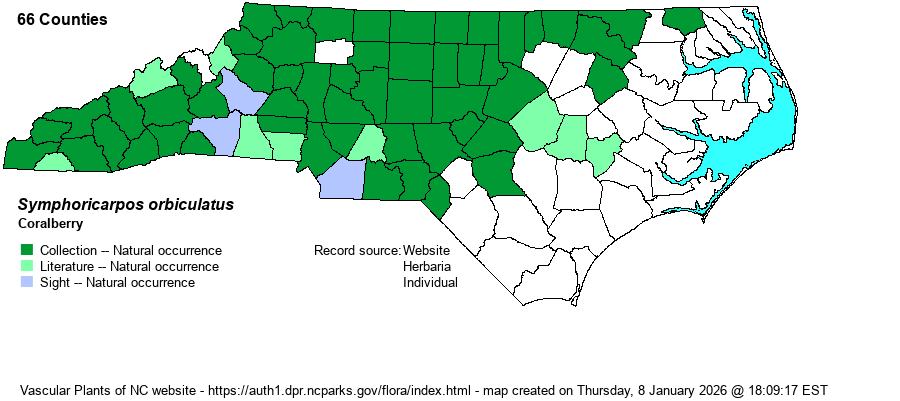| Author | Moench | |
| Distribution | Present over most of the Mountains and Piedmont; also occurs in the western Coastal Plain, but mainly in the northern portions, near the VA line.
This species has a wide east-west range, occurring from the Atlantic Coast west to CO and TX. It ranges north to MA, NY, and MN and south mainly to northern GA, but sparingly occurs in FL and east to TX.
| |
| Abundance | In the Piedmont it is infrequent to fairly common, but slightly less numerous in the Mountains, where mainly infrequent. Rare to very uncommon in the Coastal Plain portion of the range, and probably limited mainly to brownwater river floodplains there. | |
| Habitat | This is a species primarily of circumneutral soils, but usually where mesic to somewhat dry. Habitats include Basic Oak-Hickory Forest, Basic Mesic Forest, rich floodplain forests, mafic glades such as Diabase Glade and Xeric Hardpan Forest, and also in thickets on such soils. It can occur in weedy pastures and brushy areas, and it does show some tendency to becoming weedy, especially as it is rhizomatous. Because it has a fleshy fruit (berry), it is likely that birds distribute the species into weedy spots where it may seem to appear to be locally “exotic”. | |
| Phenology | Blooms from late July into September; fruits from September to November, often persisting into the winter. | |
| Identification | This is a fairly low, colonial shrub with conspicuously slender branches/twigs, reaching about 3-4 feet tall. It has deciduous, opposite leaves that are quite small, being ovate to elliptic, entire, and averaging only about 1-inch long. It usually can be confused only with exotic species such as Chinese Privet (Ligustrum sinense), which has shinier green leaves (tending to remain on the plants through the winter) and is usually much taller. In flower or fruit, Coralberry cannot be confused, however. Though it has small and inconspicuous pale green flowers in the leaf axils, the fruits are strikingly magenta-colored; these purple berries remain in a tight cluster often well into winter on naked twigs, rendering this otherwise overlooked shrub quite attractive. | |
| Taxonomic Comments | None
| |
| Other Common Name(s) | Buckbrush, Indian Currant | |
| State Rank | S4 [S5] | |
| Global Rank | G5 | |
| State Status | | |
| US Status | | |
| USACE-agcp | FACU link |
| USACE-emp | FACU link |

